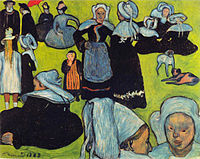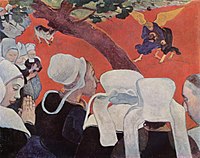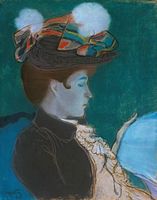Cloisonnism

1889, oil on canvas
Albright-Knox Art Gallery, Buffalo, New York
Cloisonnism is a style of post-Impressionist painting with bold and flat forms separated by dark contours. The term was coined by critic Édouard Dujardin on the occasion of the Salon des Indépendants, in March 1888.[1] Artists Émile Bernard, Louis Anquetin, Paul Gauguin, Paul Sérusier, and others started painting in this style in the late 19th century. The name evokes the technique of cloisonné, where wires (cloisons or "compartments") are soldered to the body of the piece, filled with powdered glass, and then fired. Many of the same painters also described their works as Synthetism, a closely related movement.
In The Yellow Christ (1889), often cited as a quintessential cloisonnist work[by whom?], Gauguin reduced the image to areas of single colors separated by heavy black outlines. In such works he paid little attention to classical perspective and eliminated subtle gradations of color—two of the most characteristic principles of post-Renaissance painting.
The cloisonnist separation of colors reflects an appreciation for discontinuity that is characteristic of Modernism.[2]
Gallery
-
 Émile Bernard Self-portrait with portrait of Gauguin, dedicated to Vincent van Gogh. Bernard, 1888
Émile Bernard Self-portrait with portrait of Gauguin, dedicated to Vincent van Gogh. Bernard, 1888 -
 Émile Bernard, Breton Women in the Meadow, August 1888.
Émile Bernard, Breton Women in the Meadow, August 1888. -
 Paul Gauguin, Vision after the Sermon, 1888.
Paul Gauguin, Vision after the Sermon, 1888. -
 Louis Anquetin, Reading Woman, 1890
Louis Anquetin, Reading Woman, 1890 -
Resources
Notes
See also
External links
- Cloisonnism at ArtFacts
- v
- t
- e
movements
- Neo-Impressionism
- Divisionism
- Pointillism
- Cloisonnism
- Les Nabis
- Synthetism
- Symbolism
- Art Nouveau
- Cuno Amiet
- Charles Angrand
- Émile Bernard
- Edvard Munch
- Pierre Bonnard
- Marius Borgeaud
- Paul Cézanne
- Henri-Edmond Cross
- Maurice Denis
- Georges Dufrénoy
- Paul Gauguin
- Hippolyte Petitjean
- Paul Ranson
- Odilon Redon
- Henri Rousseau
- René Schützenberger
- Paul Sérusier
- Georges Seurat
- Paul Signac
- Henri de Toulouse-Lautrec
- Charles Laval
- Georges Lemmen
- Maximilien Luce
- Vincent van Gogh
- Théo van Rysselberghe
- Félix Vallotton
- Édouard Vuillard
movements
- Impressionism
- Modernism
- Modern art
- Secessionism
















